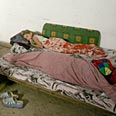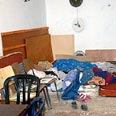
A run down shelter in Kiryat Shmona

Karmiel shelter
Photo: Reuters

A shelter in Safed
Photo: Niv Calderon
Less than a month after the war in Lebanon ended,
Prime Minister Ehud Olmert presented
to the Cabinet a special plan to rehabilitate and strengthen Haifa and the north at a cost of NIS 4 million (about $950,000). Two months later Ra’anan Dinur, Director General of the Prime Minister’s Office, declared that most of the shelters in the north were prepared. Are they really? An investigation by Yediot Ahronot found that most shelters in the north are far from being ready for the next war.
Most towns in the north have still not received a single shekel for upgrading shelters. This is the case in Ma’a lot, Kiryat Shmona, Safed, Nazareth, Shlomi, and other towns.
A source in the Prime Minister’s Office stated that as of today, some 90 pecent of the public shelters in the north are usable, which means they can be occupied for a short time. However, the experience of last summer indicates that this is not enough. In the last war residents of the north were forced to stay in shelters for days on end without approcpriate amenities. On this issue nothing has changes since last year.
Ynet inquiry
Roee Mandel
Seven months after Lebanon war, public bomb shelters nationwide remain in desperate need of renovations. Not surprisingly, situation most severe in Arab and Druze villages
Some of the towns, such as Kiryat Shmona, Safed, and Karmiel, chose not to wait for the government, and raised money to renovate the shelters. Fifty public shelters have been renovated in Kiryat Shmona, and 80 in Safed, all by Livnot U’Lehibanot, with funding from UJA Federation of New York. Some of the money used for renovating shelters in Karmiel was raised from the Pittsburgh Jewish community.
In Tiberias and Haifa the situation is better. Tiberias received a NIS 320,000 (about $76,000) budget and started upgrading shelters, though another NIS 1 million are still needed. Haifa received NIS 165 million ($39 million) in January to rehabilitate industrial areas harmed during the war, to upgrade shelters, and for other projects, and according to the Haifa municipality, all public shelters in the city are in very good shape. On the other hand, many of the city’s private shelters are still in disgraceful condition, with dirt, broken furniture, cockroaches, and a strong stench.
A national sample conducted for the Association for Housing Culture and the Ministry of Housing indicates that as of today, some 80 percent of the private shelters in the northern region are not ready for an emergency. Many shelters have become storage rooms over the years, and are full to bursting. In some buildings residents did not wait for government aid, choosing instead to clear the shelters and collect the money for renovations, but most residents of the north are not able to afford this. “It’s a catastrophe,” says a senior offical in the Housing Ministry.
About a month ago, nine months after the war, Prime Minister Ehud Olmert toured the north and promised to budget NIS 100 million ($24 million) to upgrade shelters for prolonged occupancy. Olmert promised that the entire project would be completed within nine months.
Officials have recently been sent to assess the state of the shelters. According to a source in the Prime Minister’s Office, the work will include not only the 3,300 public shelters in the north, but also some 3,000 private shelters. Floors and bathrooms will be replaced, shelters will be painted, and fans will be installed. Contractors are being instructed to complete the work within a few months. “There are many objective problems,” says a source in the Prime Minister’s Office. “It doesn’t just depend on us.”
Hospitals in the north are also in a sorry state. In December the government promised to give NIS 400 million ($95 million) for protection of seven hospitals, but to this day nothing has been done. Rambam Hospital, which treated hundreds of wounded during the war, prepared a plan for reinforcing the hospital which has not been implemented. The promised NIS 160 million ($38 million) have not been given, and the ER continues to function with a tin roof. The situation in other northern hospitals is similar, other than in Nahariya, where an underground hospital was dedicated four years ago.
Idan Avni, Yisrael Moshkovitz, Lior El-Hai, Eitan Glickman, Goal Beno, Eran Navon, and Ofer Petersburg contributed to report.















